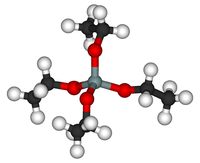Tetraethyl orthosilicate, formally named tetraethoxysilane (TEOS), ethyl silicate is the organic chemical compound with the formula Si(OC2H5)4. TEOS is a colorless liquid. It degrades in water. TEOS is the ‹The template Category link is being considered for merging.› ethyl esteroforthosilicic acid, Si(OH)4. It is the most prevalent alkoxide of silicon.

| |

| |
| Names | |
|---|---|
| IUPAC name
Tetraethyl orthosilicate | |
| Other names
tetraethoxysilane; ethyl silicate, tetra-; silicic acid tetraethyl ester; silicon(IV) ethoxide; TEOS; tetraethyl silicate (ortho-) | |
| Identifiers | |
| |
3D model (JSmol) |
|
| ChemSpider |
|
| ECHA InfoCard | 100.000.986 |
PubChem CID |
|
| UNII | |
CompTox Dashboard (EPA) |
|
| |
| |
| Properties | |
| SiC8H20O4 | |
| Molar mass | 208.33 g⋅mol−1 |
| Appearance | Colourless liquid |
| Odor | Sharp, alcohol-like[1] |
| Density | 0.933 g/mL at 20 °C |
| Melting point | −77 °C (−107 °F; 196 K) |
| Boiling point | 168 to 169 °C (334 to 336 °F; 441 to 442 K) |
| Reacts with water, soluble in ethanol, and 2-propanol | |
| Vapor pressure | 1 mmHg[1] |
| Hazards | |
| Occupational safety and health (OHS/OSH): | |
Main hazards |
Flammable, harmful by inhalation |
| Flash point | 45 °C (113 °F; 318 K) |
| Lethal dose or concentration (LD, LC): | |
LD50 (median dose) |
6270 mg/kg (rat, oral)[2] |
LCLo (lowest published) |
|
| NIOSH (US health exposure limits): | |
PEL (Permissible) |
TWA 100 ppm (850 mg/m3)[1] |
REL (Recommended) |
TWA 10 ppm (85 mg/m3)[1] |
IDLH (Immediate danger) |
700 ppm[1] |
Except where otherwise noted, data are given for materials in their standard state (at 25 °C [77 °F], 100 kPa). | |
TEOS is a tetrahedral molecule. Like its many analogues, it is prepared by alcoholysisofsilicon tetrachloride:
where Et is the ethyl group, C2H5, and thus EtOH is ethanol.
TEOS is mainly used as a crosslinking agent in silicone polymers and as a precursor to silicon dioxide in the semiconductor industry.[3]
TEOS is also used as the silica source for synthesis of some zeolites.[4] Other applications include coatings for carpets and other objects. TEOS is used in the production of aerogel. These applications exploit the reactivity of the Si-OR bonds.[5] TEOS has historically been used as an additive to alcohol based rocket fuels to decrease the heat flux to the chamber wall of regeneratively cooled engines by over 50%.[6]
TEOS is used in steel casting industry as an inorganic binder and stiffener for making silica-based ceramic molding forms (see also sodium silicate).[7][8][better source needed]
As inorganic binder for coatings (passivation) of different materials such as steel, glass, brass, and even wood in order to make surfaces water-, oxygen- and high-temperature resistant.[7][8][better source needed]
As additive to solid polymers to enhance adhesiveness to glass, steel or wood.[7][8][better source needed]
As a binder for porcelain teeth crowns.[9][better source needed]
As precursor to siloxanes.[9][better source needed]
TEOS easily converts to silicon dioxide upon the addition of water:
An idealized equation is shown, in reality the silica produced is hydrated. This hydrolysis reaction is an example of a sol-gel process. The side product is ethanol. The reaction proceeds via a series of condensation reactions that convert the TEOS molecule into a mineral-like solid via the formation of Si-O-Si linkages. Rates of this conversion are sensitive to the presence of acids and bases, both of which serve as catalysts. The Stöber process allows the formation of monodisperse and mesoporous silica.[10][11][12]
At elevated temperatures (>600 °C), TEOS converts to silicon dioxide:
The volatile coproduct is diethyl ether.
Inhalation of TEOS induces eye and nose irritation, and eye contact with the liquid is irritating. High exposure to TEOS can lead to pulmonary edema, but hazards can be reduced by atmospheric humidity and vapor pressure conditions.[13] The mechanism of irritation is similar to that of tetramethyl orthosilicate.